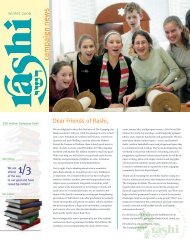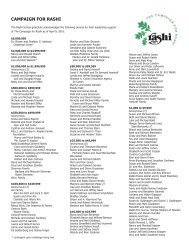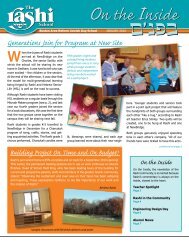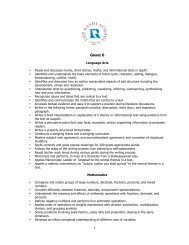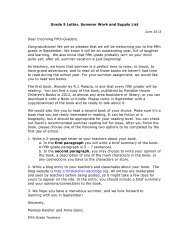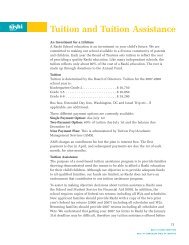Social Studies - The Rashi School
Social Studies - The Rashi School
Social Studies - The Rashi School
You also want an ePaper? Increase the reach of your titles
YUMPU automatically turns print PDFs into web optimized ePapers that Google loves.
GRADE ONEStudents will be able to….• Locate Washington DC on a map of the United States and identify it as the capital ofthe United States of America; locate Boston on a map of the United States and identifyit as the capital of Massachusetts.• Locate Israel on a world map and describe Israel as Eretz Israel. Locate Jerusalemon a map of Israel and identify it as the capital of Israel.• Identify the current President of the United States, describe what presidents do, andexplain that they get their authority from a vote by the people.• Identify the current Prime Minister of Israel, describe what prime ministers do, andexplain that they get their authority from a vote by the people, similar to the presidentof the United States.• Recite the Pledge of Allegiance, explain its meaning, and sing national songs suchas America the Beautiful, My Country ’Tis of <strong>The</strong>e, God Bless America, and <strong>The</strong> Star Spangled Banner.• Demonstrate the ability to sing Hatikva and other “Israel” songs.• Describe the qualities and distinctive traits of famous Americans of different ethnicgroups, faiths, and historical periods, after reading or listening to stories about them.• Describe the qualities and distinctive traits of famous Israelis of different ethnic groups, faiths, andhistorical periods, after reading or listening to stories about them.• Explain that Americans have a variety of different religious, community, and family celebrations andcustoms, and describe celebrations or customs held by membersof the class and their families.• Recognize and address the basic human need for food, shelter and clothing, anddescribe how different people meet their needs, depending on different economicstatus and cultural/national identity.• Describe the growth, distribution and consumption of apples and relate this to the significance of theRosh Hashanah tradition of apples and honey.• Describe the historical and contemporary methods of production for wool, textileand clothing.• Describe the historical and contemporary methods of creating shelters and thevariety of shelters in the world.• Describe factors that impact how shelters are designed and built (i.e., weather,available materials and resources, cultural beliefs).• Describe the social justice connection with the need for clothing.
GRADE TWOStudents will be able to….• Describe how maps, atlases, and globes are used to communicate information indifferent ways.• Identify map features (compass rose, symbol key, scale) and use them to readmaps and globes.• Know that an atlas is a resource for geographic information and use the indexcorrectly to find specific locations.• Locate major rivers in the world, including the Mississippi, Amazon, Yangtze, and Nile,and describe similarities and differences among the cultures living along these rivers.• Explain why Native Americans settled along the Charles River and how they met theirbasic needs for food, clothing, and shelter through the use of natural resources foundin that environment.• Explain why Colonists settled along the Charles River and contrast their riverside lifeto Native American culture.• Describe how Colonial settlers and Native Americans along the Charles River relatedto – and made an impact on – one another.• Compare and contrast Native American and early Colonial life in Massachusetts(to 1820) with our lives today.• Identify and describe modern uses of the Charles River.• Describe the impact of settlement on river environments in both ancient and modern times.• Recognize water resource challenges around the world and identify people and organizations takingsteps to make fresh, clean water available to all living things.• Describe the Holocaust as a time when Jews and others lost their human rights.
GRADE THREEStudents will be able to….• Locate all continents and oceans on a map of the world.• Locate the United States, the Atlantic and Pacific Oceans, Gulf of Mexico, Mississippiand Rio Grande Rivers, the Great Lakes, Hudson Bay, and the Rocky and Appalachian Mountainranges on a map of North America.• Locate the current boundaries of the United States (including Alaska and Hawaii) ona map of North America, and locate regions throughout the continent.• Identify the states, state capitals, and major cities in each region of the United States.• Describe the climate, major physical features, and major natural resources in eachregion of North America.• Identify and describe the unique features of the United States (e.g. the Everglades,the Grand Canyon, Mount Rushmore, the Redwood Forest, Yellowstone NationalPark, and Yosemite National Park).• Identify Washington, D.C. as the capital of the United States and locate it on a mapof the United States.• Locate Canada (and its provinces) and Mexico on a map of North America.• Locate all Western and Eastern European countries on a map of Europe.• Describe the diversity of the American people by identifying contributions to American culture of at leastthree indigenous peoples in different areas of the country.• Describe the diversity of the American people by identifying distinctive contributionsto American culture of major immigrant groups, locating their countries of origin andwhere they tended to settle in large numbers.• Describe causes of major waves of immigration of Jews from Eastern Europe to theeastern United States, and describe the varied experiences of immigrants.
GRADE SIXStudents will be able to….• Explain political and economic factors that contributed to the American Revolution;explain the role of Massachusetts and important leaders and events from Massachusetts.• Explain the influence and ideas of the Declaration of Independence.• Analyze and explain the process and reasons for the adoption of the Articles of Confederation anddescribe the crucial events leading to the Constitutional Convention.• Describe the debate between Federalists and Anti-Federalists over the ratificationof the Constitution, and explain key ideas contained in the Federalist Papers.• Describe the causes, course, and consequences of America’s westward expansionand its growing diplomatic assertiveness.• Explain the importance of the development of the Transcontinental Railroad, theinfluence it had on the growth of a market economy, and its effect on the demiseof Great Plains Native American cultures.• Describe the rapid growth of slavery in the South after 1800, and analyze slave lifeand the struggle for freedom on plantations and farms across the South.• Compare and contrast the Jewish notion of slavery with the treatment of slaves in Africa.• Describe how the cultures and economies of the North/South contributed to the divide between them inthe early 19th century; identify, on a map of the US, Union and Confederate States at the outbreak ofthe Civil War.• Summarize the critical developments leading to the Civil War including the Missouri Compromise, theDred Scott Supreme Court case, the Lincoln-Douglas debates,and the election of Abraham Lincoln.• Analyze Lincoln’s views on slavery and the political obstacles he encountered.• Describe various examples of the effects of the Civil War including physical and economic destruction,staggering loss of human life, and the increased role of the federal government.• Explain the policies and consequences of Reconstruction.• Explain the various causes of the Industrial Revolution including important technologicaland scientific advances, and the role of business leaders, entrepreneurs, and inventors.• Describe how the Industrial Revolution led to the development of a factory economy,and how the factory economy transformed the Northern states.• Discuss the emergence and impact of the textile industry in New England and industrial growth ingeneral.
GRADE SEVENStudents will be able to….• Describe the impact of technology on the expansion of cities at the beginning of the20th century, including automobiles and elevators, and the creation of industrial townsand their contribution to an ethnically diverse working class.• Characterize the Gilded Age, explaining the reasons for major population growth in the United States,and the polarization of wealth that resulted from industrial expansion.• Recognize the period between 1880 and 1930 when more than two million Jews leftEurope, as a major event in Jewish history; explain reasons for this huge wave ofemigration and immigration to the United States• Explain the conditions that led to the growth of the labor union movement, and theeventual creation of the American Federation of Labor (AFL).• Analyze the causes and course of America’s growing role in world affairs from theCivil War to World War I.• Explain the course and significance of President Wilson’s wartime diplomacy, includinghis Fourteen Points, the League of Nations, and the failure of the Versailles treaty.• Analyze the causes of America’s policy of isolationism, and explain how World War I challengedisolationism; explain the strength of American isolationism after World War Iand analyze its impact on U.S. foreign policy.• Describe the various causes and consequences of the global depression of the1930s including the Stock Market Crash, and analyze how Americans respondedto the Great Depression.• Explain the agricultural and economic damage caused by the Dust Bowl, and the consequences of theDust Bowl in relation to the Great Depression.• Explain how the Great Depression and the New Deal affected American society.• Recognize the economic role of World War II in contributing to the end of the Depression.• Compare and contrast various forms of government including Constitutionalrepresentative democracy, monarchy, oligarchy, autocracy, and pure democracy.• Identify the three branches of American government established by and elaboratedin the Constitution, and describe the role that each branch plays in preventing animbalance of political power.• Identify the rights given to American citizens in the Bill of Rights and analyzehow the Supreme Court has interpreted the Bill of Rights differently over thecourse of American history.• Describe the origins of the Western government, particularly the law and Americanlegal system, in Mishna Sanhedrin.



